Reviews
Stanley Kubrick
USA, 1955
Credits
Review by Leo Goldsmith
Posted on 03 March 2010
Source MGM/UA DVD
Categories Kubrick
Stanley Kubrick made only two films set in his native city of New York: his 1955 second feature, Killer’s Kiss, and his final film, Eyes Wide Shut. And if we are to follow Kubrick in taking the former as his first “official” film - after the early documentaries and a first feature he later disavowed - then these films create a curious forced symmetry in the director’s career, bookending it with stories about the city in which he was born. The two films share more than setting: each triangulates an ambiguously characterized hero, villain, and love-interest in a classic noir scenario involving lust and violence in a slightly off urban dreamworld. That the latter film is infinitely more subtle and complex in these ambiguities ought to surprise no one. But Killer’s Kiss is nonetheless a very impressive film that showcases the young filmmaker’s talent as a director and cinematographer, and presages many of the themes of his later work.
Here, Kubrick once again reworks images and ideas from “Prizefighter,” his 1949 photoessay for Look magazine and the basis for his first film Day of the Fight. But with its catchy and utterly nonsensical pulp title, Killer’s Kiss expands upon these earlier works considerably, matching images of gritty gutter-realism with increasingly lurid scenarios, and garnishing its narrative with an array of visual witticisms and a swirling sense of chronology. Flashbacks within flashbacks, artful action setpieces, and a mix of careful chiaroscuro lighting and raw guerilla cinematography all suggest a director with something to prove, whose ambitions push the boundaries of both genre and budget.
A far cry from the director’s prior subject, real-life middleweight champ Walter Cartier, pugilist Davey Gordon is a has-been from the start, an endearing lug whose susceptibility to love suits the “weak chin” that the TV sportscaster tells us he is plagued by. In other words, he is one of Kubrick’s many castrated male characters, except that he is also a wistful and romantic soul who dreams of escaping the big city for his uncle’s Seattle horse ranch. Davey’s aspirations may seem hokey and a tad unlikely, but we are nonetheless immediately made aware of his body and particularly how the city seems to contain or confine it: first as he wanders aimlessly across the grand concourse of the old Penn Station, and later as he waits for the moment of “the big fight,” pacing nervously within the tight parameters of his tiny apartment. (In the first of a number of striking visual puns, Kubrick compares this apartment to the fishbowl Davey keeps there, and even frames Davey through glass, distorting his features as if his face has already been pummeled.) Finally, in the visceral, even erotically charged boxing match, Davey circles the still more claustrophobic confines of the ring, where he suffers humiliation and defeat at the hands of his opponent.
Across town, at just the same moment, another humiliation is underway: that of Gloria Price at the hands of a gangster named Vince, who owns the Times Square dancehall Pleasure Land where Gloria works as a professional dance partner. Gloria also happens to live in the apartment just across the air shaft from Davey’s, and when the slick, swarthy Vince pays a late-night visit to knock around the blonde, delicate Gloria (who looks a lot like Eva Marie Saint from On the Waterfront, released the previous year), Davey jumps to the rescue. Naturally, these two bruised souls fall in love - or seem to, at any rate - and naturally this incites Vince’s jealous rage. But Gloria is not quite what she seems—or is she? In spite of a couple of flashbacks narrated by Gloria herself, the film never quite decides whether she is a damsel-in-distress or a femme fatale, or if indeed these qualities are simply interchangeable (and unknowable) in “Woman.” Kubrick is often (and sometimes unfairly) criticized for the lack of complexity he lends to his female characters, but here I suspect Gloria’s rather flat characterization has as much to do with the acting and the trappings of the genre as it does Kubrick’s own ideas about the female mind.
While its classic noir scenario and characteristically unfavorable notions of the fairer sex may occasionally seem regrettably simplistic, Killer’s Kiss nonetheless has much to say about its setting. The film affords breathtaking glimpses of a New York now long gone with a documentary feel for the city’s streets and back alleys much like that of Dassin’s The Naked City. Penn Station, Times Square, the deserted warehouse districts on the west side of Manhattan, even a nameless, expressionistic alleyway where Davy’s manager, mistaken for the boxer himself, is beaten to death: each not only reveals the underbelly of a city with which Kubrick was intimately familiar, but also pointedly harkens back to the images of earlier photographers of urban spaces. The flashbulb poet Weegee is of course the most obvious, but even the earlier work of Alfred Stieglitz and the subway photographs of Walker Evans receive almost direct visual quotations in the film, as if Kubrick is deliberately drawing on the visual mythology of the urban space.
For as much as it gives us a rare view into the seedy public spaces of 1950s New York, Killer’s Kiss also emphasizes the loneliness and isolation the city engenders. Kubrick is able to evoke this mood even in those nominally public spaces: the vast concourse of the old Penn Station, where Davey paces back and forth at the beginning of the film, or the deserted cobblestone corridors of warehouse-land in the wee hours. But it’s in his carefully composed interior scenes where he drives the point home further, often with the familiar wry humor we will come to recognize in his later films. There is, for example, the ironic image of Gloria ascending the steps of Pleasure Land for what she believes is the last time, with a chessboard pattern on the floor and a sign that reads, “Watch Your Step” above her head.
Like the fishbowl in Davey’s fishbowl-like apartment, these images stand for the sense of confinement and exposure that one feels in the urban space, and as one of the photo-documenters of this world, Kubrick would have known intimately how the media’s own voyeurism contributes to its particular feeling of paranoia. (His own famous photograph of two lovers on a fire escape illustrates this with almost self-conscious perversion, and it could well be an image from Killer’s Kiss.) Even the visceral freedom that the boxing ring seems to allow - which Kubrick shoots in the same iconic, smoky, high-contrast black-and-white from Day of the Fight and later inspired Scorsese’s similar sequences in [Raging Bull](/reviews/raging bull/) - is belied and minimized when broadcast on glowing tube of the TV. Davey’s defeat, seen by Uncle George and Aunt Grace across the country and by Vince as he molests Gloria in the backroom office at Pleasure Land, suggests how the city has reduced Davey - or, even less, his body and its humiliation - to mere spectacle.
By the end of the film, Davey’s resolution is to break free from the city’s disorienting, mazelike topography, and he does so, literally crashing through the window of a Chelsea warehouse, running through streets and alleys, climbing up a fire escape, and dashing across rooftops. This final chase sequence is as much a showcase for Kubrick’s own brand of liberated filmmaking as it is for his protagonist’s symbolic liberation, just as its deservedly famous denouement in a mannequin factory functions both as a thrilling (and almost dangerously unhinged) action sequence and as another visual witticism commenting upon the story. Awkwardly and quite realistically swinging at each other with an axe and a harpoon, Davey and Vince gouge and smash every plastic, naked female form that gets in their way in a climax worthy of Welles’s House of Mirrors sequence at the end of The Lady from Shanghai. Ultimately, Killer’s Kiss offers its audience a generic happy ending for Davey and Gloria, perhaps the last facile happy ending in any of Kubrick’s films. But these mannequins remain strangely indelible, finding yet another curious symmetry in the disposable, statuesque female figures in Kubrick’s final film.
More Kubrick
-
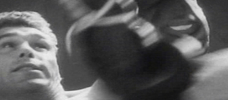
Stanley Kubrick’s Early Documentaries
1951-53 -
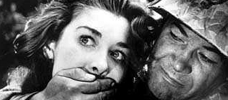
Fear and Desire
1953 -

Killer’s Kiss
1955 -
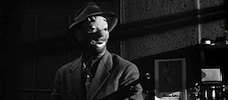
The Killing
1956 -
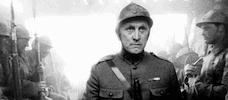
Paths of Glory
1957 -
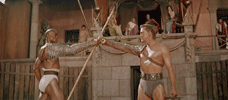
Spartacus
1960 -

Lolita
1962 -
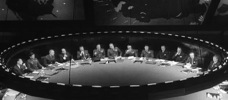
Dr. Strangelove or: How I Learned to Stop Worrying and Love the Bomb
1964 -

2001: A Space Odyssey
1968 -

A Clockwork Orange
1971 -
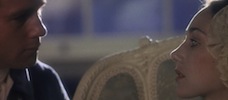
Barry Lyndon
1975 -
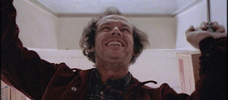
The Shining
1980 -

Full Metal Jacket
1987 -
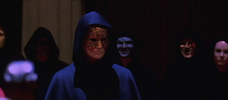
Eyes Wide Shut
1999 -

A.I.
2001
We don’t do comments anymore, but you may contact us here or find us on Twitter or Facebook.



